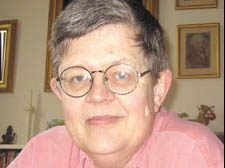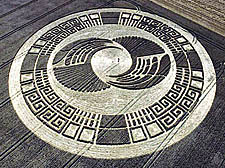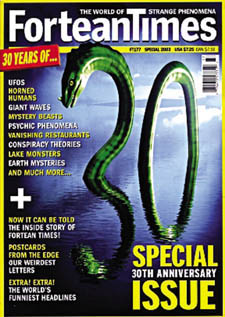|
|
 |
| |
 Fortean
Times Editor, Paul Sievking Fortean
Times Editor, Paul Sievking

A crop circle near Silbury Hill, Avebury,Wiltshire which
appeared in June 2005.

The 30th anniversary edition of the Fortean Times |
Tales of the unexplained
Weird and wonderful happenings
will be the subject of a conference organsied by cult magazine
the Fortean Times.
Dan Carrier talks to its editor
ALIENS and unidentified flying objects. The Loch Ness Monster
and Big Foot. Bizarre earthworks and oddly-shaped rocks.
Such is the daily life of Paul Sieveking, the editor of cult
mystery magazine the Fortean Times.
Sieveking, who lives in Queen’s Crescent, has been involved
in the Fortean Times in Kentish Town for more than 30 years.
And this weekend the magazine’s annual conference –
the Uncon, as in Unconvention – brings together some of
the leading proponents and sceptics of weird and wonderful happenings
to the Friends Meeting House in Euston.
It is a weekend that encapsulates the thinking behind the man
who the magazine is named after: Charles Fort, the New York
philosopher who wrote in 1919 The Book Of The Damned. It’s
subject matter includes the staple fare of Victorian/ Edwardian
mysteries – fish and other objects falling from the skies;
strange weather, fairy sightings, spontaneous human combustion
and the like.
Fortean thought is based on a rational approach to the unexplained.
As Paul explains: “It goes against the school that says
if you can’t explain how something happens, it doesn’t
happen.”
Fort believed that scientists were akin to religious fundamentalists
– sure they are right, and therefore blinkered to the possibilities
provided by other points of views.
Sieveking believes there is more to the stories he prints each
month than just wacky tales: rather than dismiss people who
believe they were kidnapped by aliens, he is interested in the
sociological reasons, be it what creates such delusions in the
minds of people, for these stories to affect so many.
Examples can be found in the way different cultures have consistent
reports of weird, supposedly unexplainable happenings.
Sieveking continues: “Bleeding statues or appearances of
the Virgin Mary happen in Catholic countries, which leads you
to an cultural reason behind such sightings.
His interest stems partly from his academic background. Sieveking
graduated from Cambridge University, where he studied anthropology
and archaeology – the perfect grounding, it seems, for
editing magazine of this type.
The magazine has been variously described as ‘the old Curiosity
Shop of Journalism’ (Keith Waterhouse, the Spectator),
and ‘a magazine that inspires intense joy in its readers,”
(The Independent) and ‘Britain’s most astounding magazine’,
(Time Out).
After graduating in 1971, Paul set up a base in a squat in Haverstock
Hill, from which he published books and edited the Biographical
Archive of Great Britain.
But it was a general disillusionment he felt at the failure
of the promise shown by the 1960s generation to change the world
that drew him towards the Fortean Times.
He explains: “There was the hope created by sixties movements,
of Paris, 1968.
“It became very quickly the ‘me generation’,
and The Fortean Times presented a way to confront orthodoxy,
confront conservative thinking and above all, it is full of
irreverent humour.”
The readership has slowly expanded, as has the size of the magazine.
“Our readers tend to be information junkies who read lots
of books and have a thing about data,” he says. “And
lots of scientists read us surreptiously,” he adds with
a grin.
They rely on the readers who send in quirky stories from around
the world. “We seldom get things that are made up,”
Sieveking continues. “You can tell the ones that are outright
liars – they are so unrestrained, it gives them away. I
got a letter about a ‘jackalope’, – rabbit with
antlers, which someone said they had seen in the wilds of Winsconsin.
The world is a strange enough place as it is. There is no need
to make things up.” |
|
 |
|
 Fortean
Times Editor, Paul Sievking
Fortean
Times Editor, Paul Sievking

